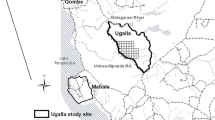Summary
Variation in weight, wing length and bill length in a population of grey-crowned babblers is influenced primarily by sex and age, but correlations with size of social unit, with reproductive success, and with vegetation are also detectable (Table 1). The latter correlations vary with sex, age, and status as helper or breeder. Differential wear according to behavioral role, competition for status, incubation, and inheritance are discussed as possible causal mechanisms. Helpers were not detectably smaller in any dimension than breeders of the same age and sex. Male and female non-breeding helpers differ in patterns of morphological correlation, suggesting that they have different behavioral roles. Breeding males have a unique pattern of morphological correlation, suggesting that their foraging behavior differs from breeding females and non-breeders.
Similar content being viewed by others
References
Brown JL (1969) Territorial behavior and population regulation in birds. Wilson Bull 81:293–329
Brown JL (1974) Alternate routes to sociality in jays—with a theory for the evolution of altruism and communal breeding. Am Zool 14:63–80
Brown JL (1978) Avian communal breeding systems. Annu Rev Ecol Syst 9:123–155
Brown JL (1979) Growth of nestling Grey-crowned babblers, with notes on determination of age in juveniles. Emu 79:1–6
Brown JL, Brown ER (1981) Kin selection and individual selection in babblers. In Alexander RD, Tinkle D (eds) Natural selection and social behavior: recent results and new theory. Chiron Press, New York
Brown JL, Dow DD, Brown ER, Brown SD (1978) Effects of helpers on feeding of nestlings in the Grey-crowned babbler (Pomatostomus temporalis). Behav Ecol Sociobiol 4:43–59
Counsilman JJ, King B (1977) Ageing and sexing the grey-crowned babbler (Pomatostomus temporalis). Babbler 1:23–41
Dixon JL, Brown MB (1977) BMDP-77 biomedical computer programs P-series. University of California Press, Berkeley, California
Johnson MS, Brown JL (1980) Genetic variation among trait groups and apparent absence of close inbreeding in grey-crowned babblers. Behav Ecol Sociobiol 7:93–98
King B (1980) Social organization and behaviour of the greycrowned babbler Pomatostomus temporalis. Emu 80:59–76
Mrosovsky N, Sherry DF (1980) Animal anorexias. Science 207:837–842
Sokal RR, Rohlf FJ (1969) Biometry. Freeman, San Francisco, California
Author information
Authors and Affiliations
Rights and permissions
About this article
Cite this article
Brown, J.L., Brown, E.R. & Brown, S.D. Morphological variation in a population of grey-crowned babblers: Correlations with variables affecting social behavior. Behav Ecol Sociobiol 10, 281–287 (1982). https://doi.org/10.1007/BF00302818
Received:
Accepted:
Issue Date:
DOI: https://doi.org/10.1007/BF00302818




